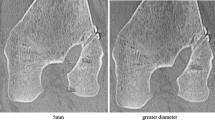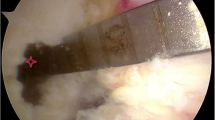Abstract
Background: Femoral tunnel location is of critical importance for successful outcome of ACL reconstruction. The aim was to study the femoral tunnel created by placing free hand guide wire through tibial tunnel, using the toggle of the guide wire in the tibial tunnel to improve femoral tunnel location.
Materials and Methods: 30 cases of a single bundle quadrupled hamstring graft anterior cruciate ligament reconstruction by trans-tibial free hand femoral tunnel creation is studied in this prospective study. The side to side play of the guide wire in the tibial tunnel was used to improve the tunnel location on femoral wall. The coronal angle of the femoral tunnel was measured on the anteroposterior radiograph. The femoral tunnel location on the lateral radiograph of the knee was recorded according to Amis method. Lysholm scoring was done preoperative and at each follow up. Assessment of laxity was done by Rolimeter (Aircast™) and pivot shift test.
Results: The mean coronal angle of the femoral tunnel in postoperative radiograph was 47°. In lateral radiograph, the femoral tunnel was found to be >60% posterior on Blumensaat line in 67% cases (n = 20) and in the 33% cases (n = 10) it was anterior. The mean Lysholm score improved from 74.6 preoperative to 93.17 postoperative with no objective evidence of laxity.
Conclusion: The free hand trans-tibial creation of the femoral tunnel leads to satisfactory coronal obliquity, but it is difficult to recreate anatomic femoral tunnel by this method as the tunnel is consistently anterior in the sagittal plane.
Similar content being viewed by others
References
Loh C, Fukuda Y, Tsuda E, Steadman J, Fu H, Woo SL. Knee stability and graft function following anterior cruciate ligament reconstruction: Comparison between 11 o’clock and 10 o’clock femoral tunnel placement 2002 Richard O’Connor Award paper. Arthroscopy 2003;19:297–304.
Stanford C, Kendoff D, Warren F, Pearle AD. Native anterior cruciate ligament obliquity versus anterior cruciate ligament graft obliquity: An observational study using navigated measurements. Am J Sports Med 2009;37:114–9.
Heming F, Rand J, Steiner ME. Anatomical limitations of transtibial drilling in anterior cruciate ligament reconstruction. Am J Sports Med 2007;35:1708–15.
Piasecki P, Bach BR Jr, Espinoza Orias A, Verma NN. Anterior cruciate ligament reconstruction: Can anatomic femoral placement be achieved with a transtibial technique? Am J Sports Med 2011;39:1306–15.
Howell M, Gittins E, Gottlieb E, Traina M, Zoellner TM. The relationship between the angle of the tibial tunnel in the coronal plane and loss of flexion and anterior laxity after anterior cruciate ligament reconstruction. Am J Sports Med 2001;29:567–74.
Chhabra A, Diduch R, Blessey B, Miller MD. Recreating an acceptable angle of the tibial tunnel in the coronal plane in anterior cruciate ligament reconstruction using external landmarks. Arthroscopy 2004;20:328–30.
Kopf S, Martin E, Tashman S, Fu FH. Effect of tibial drill angles on bone tunnel aperture during anterior cruciate ligament reconstruction. J Bone Joint Surg Am 2010;92:871–81.
Amis A, Beynnon B, Blankevoort L, Chambat P, Christel P, Durselen L, et al. Proceedings of the ESSKA scientific workshop on reconstruction of the anterior and posterior cruciate ligaments. Knee Surg Sports Traumatol Arthrosc 1994;2:124–32.
Musahl V, Plakseychuk A, VanScyoc A, Sasaki T, Debski E, McMahon J, et al. Varying femoral tunnels between the anatomical footprint and isometric positions: Effect on kinematics of the anterior cruciate ligament-reconstructed knee. Am J Sports Med 2005;33:712–8.
Arnold P, Kooloos J, van Kampen A. Single-incision technique misses the anatomical femoral anterior cruciate ligament insertion: A cadaver study. Knee Surg Sports Traumatol Arthrosc 2001;9:194–9.
Bedi A, Musahl V, Steuber V, Kendoff D, Choi D, Allen A, et al. Transtibial versus anteromedial portal reaming in anterior cruciate ligament reconstruction: An anatomic and biomechanical evaluation of surgical technique. Arthroscopy 2011;27:380–90.
Behrend H, Stutz G, Kessler A, Rukavina A, Giesinger K, Kuster MS. Tunnel placement in anterior cruciate ligament (ACL) reconstruction: Quality control in a teaching hospital. Knee Surg Sports Traumatol Arthrosc 2006;14:1159–65.
Khalfayan E, Sharkey F, Alexander H, Bruckner D, Bynum EB. The relationship between tunnel placement and clinical results after anterior cruciate ligament reconstruction. Am J Sports Med 1996;24:335–41.
Brophy H, Voos E, Shannon J, Granchi C, Wickiewicz L, Warren F, et al. Changes in the length of virtual anterior cruciate ligament fibers during stability testing: A comparison of conventional single-bundle reconstruction and native anterior cruciate ligament. Am J Sports Med 2008;36:2196–203.
Pearle D, Shannon J, Granchi C, Wickiewicz L, Warren RF. Comparison of 3-dimensional obliquity and anisometric characteristics of anterior cruciate ligament graft positions using surgical navigation. Am J Sports Med 2008;36:1534–41.
Lee C, Seong C, Lee S, Chang B, Park K, Jo H, et al. Vertical femoral tunnel placement results in rotational knee laxity after anterior cruciate ligament reconstruction. Arthroscopy 2007;23:771–8.
Golish R, Baumfeld A, Schoderbek J, Miller MD. The effect of femoral tunnel starting position on tunnel length in anterior cruciate ligament reconstruction: A cadaveric study. Arthroscopy 2007;23:1187–92.
Silva A, Sampaio R, Pinto E. Placement of femoral tunnel between the AM and PL bundles using a transtibial technique in single-bundle ACL reconstruction. Knee Surg Sports Traumatol Arthrosc 2010;18:1245–51.
Author information
Authors and Affiliations
Corresponding author
Rights and permissions
About this article
Cite this article
Sinha, S., Naik, A.K., Arya, C.S. et al. Trans-tibial guide wire placement for femoral tunnel in single bundle anterior cruciate ligament reconstruction. IJOO 49, 352–356 (2015). https://doi.org/10.4103/0019-5413.156224
Published:
Issue Date:
DOI: https://doi.org/10.4103/0019-5413.156224




